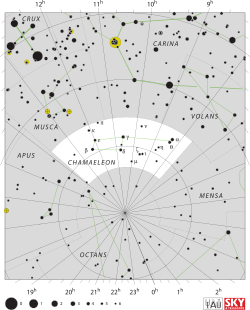Delta2 Chamaeleontis
| Delta2 Chamaeleontis (δ2) | |
 | |
| Observationsdata Epok: J2000.0 | |
|---|---|
| Stjärnbild | Kameleonten |
| Rektascension | 10t 45m 47,00487s[1] |
| Deklination | -80° 32′ 24,6785″[1] |
| Skenbar magnitud () | +4,42[2] |
| Stjärntyp | |
| Spektraltyp | B3 V[3] eller B2.5 IV[4] |
| U–B | -0,728[2] |
| B–V | -0,192[2] |
| Astrometri | |
| Radialhastighet () | +22,6[5] km/s |
| Egenrörelse (µ) | RA: -17,28[1] mas/år Dek.: -29,25[1] mas/år |
| Parallax () | 9,30 ± 0,13[1] |
| Avstånd | 351 ± 5 lå (108 ± 2 pc) |
| Absolut magnitud () | -0,71[6] |
| Detaljer | |
| Massa | 5,0 ± 0,1[7] M☉ |
| Radie | 3,9[8] R☉ |
| Luminositet | 503[9] L☉ |
| Temperatur | 16 873[9] K |
| Ålder | 32,6 ± 16,3[7] miljoner år |
| Andra beteckningar | |
| δ 2 Cha, CPD-79° 556, FK5 411, HD 93845, HIP 52633, HR 4234, SAO 258593. [10] | |
Delta2 Chamaeleontis (δ2 Chamaeleontis, förkortat Delta2 Cha, δ2 Cha) som är stjärnans Bayerbeteckning, är en ensam stjärna[11] belägen i den sydöstra delen av stjärnbilden Kameleonten och är skild från den något svagare Delta1 Chamaeleontis med ca 6 bågminuter[12]. Den har en skenbar magnitud på 4,42[2] och är synlig för blotta ögat där ljusföroreningar ej förekommer. Baserat på parallaxmätning inom Hipparcosuppdraget på ca 9,3[1] mas, beräknas den befinna sig på ett avstånd på ca 351 ljusår (ca 108 parsek) från solen.
Egenskaper
Delta2 Chamaeleontis är en blå till vit stjärna i huvudserien av spektralklass B3 V[3]. Hiltner et al. (1969) gav den klassificeringen B2,5 IV,[4] vilket skulle betyda att den är en mer utvecklad underjättestjärna. Den har en massa som är ca 5[7] gånger större än solens massa, en radie som är knappt 4[8] gånger större än solens och utsänder från dess fotosfär drygt 500[9] gånger mera energi än solen vid en effektiv temperatur på ca 15 900[9] K.
Det är 70 procent sannolikhet att Delta2 Chamaeleontis ingår i Goulds bälte.[13]
Källor
- Den här artikeln är helt eller delvis baserad på material från engelskspråkiga Wikipedia, tidigare version.
Referenser
- ^ [a b c d e f] van Leeuwen, F. (2007), "Validation of the new Hipparcos reduction", Astronomy and Astrophysics, 474 (2): 653–664, arXiv:0708.1752 , Bibcode:2007A&A...474..653V, doi:10.1051/0004-6361:20078357.
- ^ [a b c d] Gutierrez-Moreno, Adelina; Moreno, Hugo (June 1968), "A photometric investigation of the Scorpio-Centaurus association", Astrophysical Journal Supplement Series, 15: 459, Bibcode:1968ApJS...15..459G, doi:10.1086/190168.
- ^ [a b] Houk, Nancy (1979), Michigan catalogue of two-dimensional spectral types for the HD stars, 1, Ann Arbor, Michigan: Dept. of Astronomy, University of Michigan, Bibcode:1978mcts.book.....H.
- ^ [a b] Hiltner, W. A.; et al. (July 1969), "MK Spectral Types for Bright Southern OB Stars", Astrophysical Journal, 157: 313, Bibcode:1969ApJ...157..313H, doi:10.1086/150069.
- ^ Evans, D. S. (June 20–24, 1966), "The Revision of the General Catalogue of Radial Velocities", in Batten, Alan Henry; Heard, John Frederick, Determination of Radial Velocities and their Applications, Proceedings from IAU Symposium no. 30, University of Toronto: International Astronomical Union, Bibcode:1967IAUS...30...57E.
- ^ Anderson, E.; Francis, Ch. (2012), "XHIP: An extended hipparcos compilation", Astronomy Letters, 38 (5): 331, arXiv:1108.4971 , Bibcode:2012AstL...38..331A, doi:10.1134/S1063773712050015.
- ^ [a b c] Tetzlaff, N.; et al. (January 2011), "A catalogue of young runaway Hipparcos stars within 3 kpc from the Sun", Monthly Notices of the Royal Astronomical Society, 410 (1): 190–200, arXiv:1007.4883 , Bibcode:2011MNRAS.410..190T, doi:10.1111/j.1365-2966.2010.17434.x.
- ^ [a b] Pasinetti Fracassini, L. E.; et al. (February 2001), "Catalogue of Apparent Diameters and Absolute Radii of Stars (CADARS) – Third edition – Comments and statistics", Astronomy and Astrophysics, 367: 521–524, arXiv:astro-ph/0012289 , Bibcode:2001A&A...367..521P, doi:10.1051/0004-6361:20000451.
- ^ [a b c d] McDonald, I.; et al. (2012), "Fundamental Parameters and Infrared Excesses of Hipparcos Stars", Monthly Notices of the Royal Astronomical Society, 427 (1): 343–57, arXiv:1208.2037 , Bibcode:2012MNRAS.427..343M, doi:10.1111/j.1365-2966.2012.21873.x.
- ^ "del02 Cha – Star", SIMBAD Astronomical Database, Centre de Données astronomiques de Strasbourg, hämtad 2016-12-11.
- ^ Eggleton, P. P.; Tokovinin, A. A. (2008), "A catalogue of multiplicity among bright stellar systems", Monthly Notices of the Royal Astronomical Society, 389 (2): 869–879, arXiv:0806.2878 , Bibcode:2008MNRAS.389..869E, doi:10.1111/j.1365-2966.2008.13596.x.
- ^ Inglis, Michael (2012), Astronomy of the Milky Way: The Observer’s Guide to the Southern Milky Way, The Patrick Moore Practical Astronomy Series, Springer Science & Business Media, p. 106, ISBN 1447106415.
- ^ Bobylev, V. V.; Bajkova, A. T. (September 2007), "Kinematics of the Scorpius-Centaurus OB association", Astronomy Letters, 33 (9): 571–583, arXiv:0708.0943 , Bibcode:2007AstL...33..571B, doi:10.1134/S1063773707090010.
Externa länkar
| ||||||||||||||||
Media som används på denna webbplats
Författare/Upphovsman: IAU and Sky & Telescope magazine (Roger Sinnott & Rick Fienberg), Licens: CC BY 3.0
IAU Chamaeleon chart


